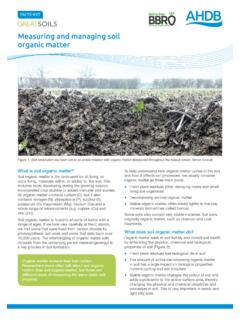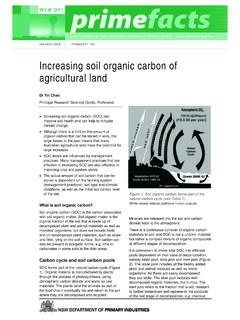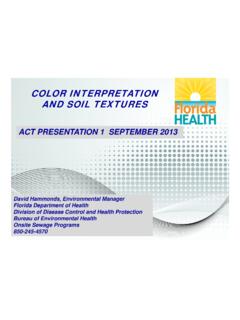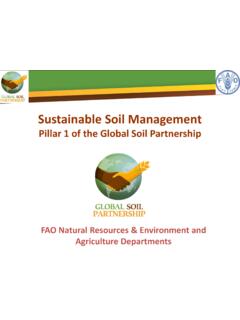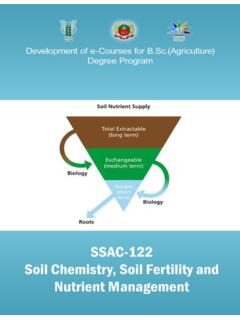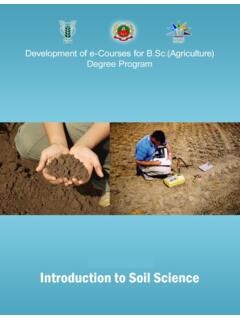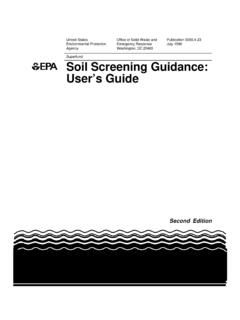Transcription of Comprehensive Assessment of Soil Health
1 Comprehensive Assessment of soil HealthThe Cornell Moebius-Clune, Moebius-Clune, Gugino, Idowu, Schindelbeck, Ristow, van Es, Thies, Shayler, McBride, Kurtz, Wolfe, and Abawi Third Editionii Comprehensive Assessment of soil Health - The Cornell FrameworkSchool of Integrative Plant Science(SIPS) soil and Crop Sciences Section232 Emerson Hall Ithaca, New York 14853 2016 by Cornell University All rights reserved. Revised June, is the policy of Cornell University actively to support equality of educational and employment opportunities. No person shall be denied employment on the basis of any legally prohibited discrimination involving, but not limited to, such factors as race, color, creed, religion, national or ethic origin, sex, sexual orientation, age, or handicap. The University is committed to the maintenance of affirmative-action programs that will assure the continuation of such equality of 0-967-6507-6-3 How to Order a CopyHardcopy (for purchase): Contact: Aaron Ristow Extension Associate soil and Crop Sciences Section 1001 Bradfield Hall, Ithaca, NY 14853 USA Phone: Email: copy (download): PDF file(s) are available to download at photo: Troy BishoppBook design and layout: Bianca Moebius-Clune and Aaron RistowUnless otherwise noted, the photos were taken by authors, soil Health team members and collaborators.
2 Comprehensive Assessment of soil Health - The Cornell Framework iii Funding for the preparation of this manual was provided by: Cornell University, Cornell Cooperative Extension, USDA-NRCS, NY Department of Agriculture and Markets, Northern New York Agricultural Development Program, USDA Northeast Region SARE, NY Farm Viability Institute, New Hampshire Charitable Foundation, NH Department of Agriculture, Food, and soil and Crop Sciences Section Comprehensive Assessment of soil Health - 1 Comprehensive Assessment of soil Health Cornell UniversityCollege of Agriculture and Life Sciences What is soil Health ? soil Health is defined as the continued capacity of the soil to function as a vital living ecosystem that sustains plants, ani-mals and humans (NRCS, 2012). Characteristics of a healthy soil include good soil tilth, sufficient rooting depth, good water storage and drainage, rich and diverse soil life, stored carbon and an adequate supply of nutrients.
3 Climate change, particularly the impacts of CO2 and N2O, can be mitigated through improved soil Health management while at the same time building soil resilience. The Health of a soil can change over time as a result of use and management, therefore it is crucial to measure soil improvement when implementing new or modifying current management Cornell soil Health Management FrameworkEach grower is generally faced with a unique production en-vironment and set of management options to address soil Health constraints. A more Comprehensive understanding of a farm s limitations and opportunities, and soil Health status can better guide producers soil management Cornell approach aims to alleviate field-specific con-straints, identified through standard measurements, and then maintain and monitor over time for improved soil Health sta-tus. To that end, we created a framework for developing soil Health Management Plans for a farm operation.
4 The framework includes: Six general steps for the planning and implementation process (below). A Comprehensive Assessment of soil Health report that explicitly provides interpretation, prioritization, and man-agement suggestions (see back). Resource concerns identified through soil Health assess-ment are linked to each indicator showing constrained soil functioning for which new management practices may be applied. A pilot management plan template that includes purpose, site information, Assessment results and interpretation, and planned practices via a multi-year management Health Management Planning Process1. Determine farm background and management history2. Set goals and sample for soil health3. For each management unit: identify and explain constraints, prioritize management4. Identify feasible management options5. Create short and long term soil Health Management Plans6. Implement, monitor and adaptThe Comprehensive Assessment of soil Health is an integral part of the Cornell soil Health Management Planning and Implementation will align their needs and abilities to allow for the development of management solutions with guidance from the CASH Comprehensive Assessment of soil Health - The Cornell FrameworkAcknowledgementsThis is the 3rd edition of the manual previously titled Cornell soil Health Assessment Training Manual.
5 The 3rd Edition Publication Team Bianca N. Moebius-Clune, formerly soil and Crop Sciences, Cornell University, Ithaca NY; now soil Health Division, USDA Natural Resources Conservation Service Daniel J. Moebius-Clune, formerly soil and Crop Sciences, Cornell University, Ithaca, NY Robert R. Schindelbeck, soil and Crop Sciences, Cornell University, Ithaca, NY Kirsten Kurtz, soil and Crop Sciences, Cornell University, Ithaca, NY Harold M. van Es, soil and Crop Sciences, Cornell University, Ithaca, NY Aaron J. Ristow, soil and Crop Sciences, Cornell University, Ithaca, NYThanksWe would like to thank the Cornell soil Health Team members and collaborators, including growers, extension educators, faculty, staff, non-profit, and governmental organizations, for their many contributions to the research and outreach activities conducted over the years since 2003. Their contributions provided the foundation on which this manual is acknowledge the contributions of Aubrey Fine for her work on the 2016 national scoring function updates and the preliminary development of regional scoring functions for physical and biological would like to thank Gordon Holloway for his significant input on book design and thanks to Kirsten Kurtz and Jenn Thomas-Murphy for designing the Comprehensive Assessment of soil Health logo and other valuable contributions to this would like to especially acknowledge the significant contributions ofCarol MacNeil, Cornell Cooperative Extension (CCE); Mike Rutzke, Cornell Nutrient Analysis Laboratory; Dorn Cox, Greenstart, NH; and Brandon Smith, NH NRCSPast contributorsJohn Ludwig, Research Assistant; Kate Duhamel, Research Assistant; Molly Shaw, CCE; Ted Blomgren, Formerly of CCE; Dale Moyer, Formerly of CCE.
6 Excerpts from Building Soils for Better Crops, 3rd Edition, by Madgdoff and van Es were adapted throughout the manual. For additional information related to this project and the revision history for this manual please visit the Cornell soil Health Team s website at: citationMoebius-Clune, , Moebius-Clune, Gugino, Idowu, Schindelbeck, Ristow, van Es, Thies, Shayler, McBride, Kurtz, Wolfe, and Abawi, 2016. Comprehensive Assessment of soil Health The Cornell Framework, Edition , Cornell University, Geneva, NY. Comprehensive Assessment of soil Health - The Cornell Framework v TMComprehensive Assessment of soil Health Training ManualEdition , 2017vi Comprehensive Assessment of soil Health - The Cornell Framework Comprehensive Assessment of soil Health - The Cornell Framework vii Table of ContentsAcknowledgements ..ivIntroduction ..viiiPart I soil Health Concepts.
7 1 What is soil ? ..2 Life in the soil ..5 What is soil Health ? ..12 Characteristics of a healthy soil ..13 Common soil constraints ..15 Part II soil Health Assessment ..19In-field soil Health Assessment ..20 Development of Cornell s Comprehensive Assessment of soil Health ..22 Assessment of soil Health overview ..25 soil sampling protocol ..27 Materials needed for one Field sampling Steps for soil soil sample storage soil sample packaging and Submission form Regulated Health scoring Regional Cumulative normal CASH summary report page Scoring Health Indicator Protocols and 37 soil Texture ..37 Available Water Capacity ..39 Surface and Subsurface Hardness ..41 Wet Aggregate Stability ..44 Organic Matter ..47 soil Protein Index ..49 soil Respiration ..51 Active Carbon ..53 Standard Nutrient Analysis.
8 55 soil Health Indicator Protocols and Scoring cont. Add-on Test: Potentially Mineralizable Add-on Test: Root Health Add-on Test: Heavy Metal Add-on Test: Health Assessment Report ..72 Six parts of the CASH summary report ..73 Using the Assessment of soil Health Using the Assessment of soil Health in soil Health Management III soil Health Management ..79 soil Health Management Planning Six Steps of the soil Health Management Planning Health Management Options and Opportunities ..87 The soil Health Management Toolbox ..87 General management considerations ..88 Tillage considerations ..88 Crop rotation considerations ..90 Cover cropping considerations ..92 Organic amendment considerations ..96 Considerations for adapting to and mitigating climate change ..98 Part IV Additional Book and Journal Resources ..104 Selected Web Resources ..107 Appendix A.
9 Sample 2017 StandardPackage Comprehensive Assessmentof soil Health Report ..110 Appendix B. soil Health ManagementPlanning Process Worksheet ..121viii Comprehensive Assessment of soil Health - The Cornell FrameworkIntroductionSoil Health , or the capacity of the soil to function, is critical to human survival. soil Health constraints beyond nutrient limitations and excesses currently limit agroecosystem productivity and sustain-ability, resilience to drought and extreme rainfall, and progress in soil and water conservation. With mounting pressure to produce food, feed, fiber, and even fuel for an increasing population, soil Health is gaining national and international attention. Research on both Assessment and management of soil Health , as well as farmers innovations in soil Health management approaches have matured over the decades. Multiple regional, national, and global efforts are now leveraging that work to reach new stakeholder audiences, so that soil Health management is expanding into mainstream agriculture.
10 Public recognition of the critical importance of maintaining and rebuilding healthy soils for long term sustainable agricul-tural production is growing. But while much progress has been made, there is much more to be done. The more Comprehensive Assessment of soil Health described in this manual is available to the public on a fee-for-service basis, and provides field-specific information on constraints in biological and physical processes, in addition to standard soil nutrient analysis ( ). In essence, the Assessment expands on a well understood approach that has been foundational to high agricultural pro-ductivity. Just as standard soil testing has informed nutrient management based on identified deficiencies and excesses since the 1900s, the Assessment developed here, similarly, identifies constraints to biological and physical soil functioning. This information then guides land managers in making targeted management decisions to plan and implement systems of soil Health management practices to alleviate identified constraints and maintain healthier soils.
